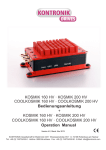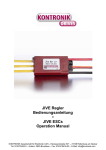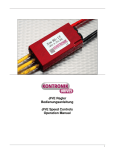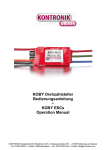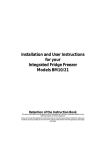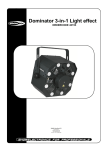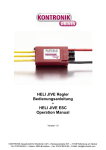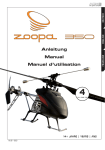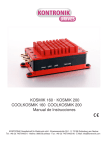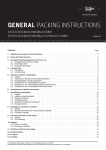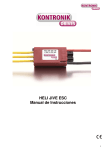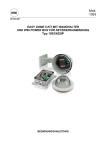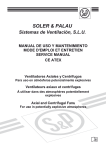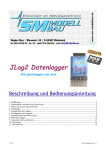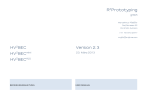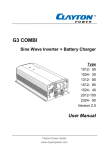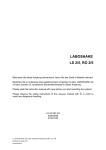Download KOSMIK 160+ HV
Transcript
Press LED 1 LED 2 D MicroS KOSMIK 160+ HV · KOSMIK 200+ HV Bedienungsanleitung + KOSMIK 160+ HV · KOSMIK 200+ HV Operation Manual KONTRONIK Gesellschaft für Elektronik mbH · Etzwiesenstraße 35/1 · D- 72108 Rottenburg am Neckar Tel: +49 (0) 7457/9435-0 · Hotline: 0800-Brushless · Fax: +49 (0) 7457/9435-90 · E-Mail: [email protected] Inhaltsverzeichnis 1 Definitionen 1.1 Lieferumfang 2 2 2 Sicherheitshinweise 3 3 Grundlagen 3.1 Sender vorbereiten, Gaskurve 3.2 Modus Programmierung 3.3 Sanftanlauf 3.4 Tiefentladungsschutz 3 3 4 4 4 Allgemeines 4.1 Eigenschaften 4.2 Kühlung und Befestigung 4.3 BEC / Betrieb ohne BEC 4.4 Ringkern 4.5 Aktiver Freilauf 4.6 Teillastfestigkeit 4.7 Sensorlose Kommutierung 4.8 Variable Taktfrequenz 4.9 Schutzmechanismen 4.10 Heli Modus 4.11 Autorotation AR (Bail-out) 4 4 5 5 6 6 6 6 6 6 6 7 5 Anschluß der Kabel 5.1 BEC-Kabel 5.2 Motor Kabel 7 7 7 6 Inbetriebnahme 6.1 Übersicht und Funktion der Modi 8 8 11 Technische Hilfe, Beratung, Hotline 11.1 Recycling 11.2 Gewährleistung 14 14 15 12 Technische Daten (Tabelle) 12.1 Kabelverlegung am KOSMIK 15 31 1 Definitionen APM EMK AR BEC Auto-Programmier-Modus Elektomotorische Kraft Autorotation/Bail-out Battery Eliminating Circuit (Schaltung zur Versorgung des Empfängers aus dem Antriebsakku) KOSMIK KOSMIK Drehzahlsteller Bedienknopf zur Modusprogrammierung Taster LED Leuchtdiode / Kontrollleuchte Modus (Modi) Betriebsart / Programm Parameter veränderbarer Wert Pitch Blatt-Anstellwinkel (Rotor) Oberseite siehe Abbildung unter Punkt 5 Unterseite siehe Abbildung unter Punkt 5 1.1 Lieferumfang 1. 2. 7 Modusprogrammierung 7.1 Modus 1 - APM 8 7.2 Modus 2 - Segler (mit Bremse) 9 7.3 Modus 3 - Motorflug/Boot (ohne Bremse) 9 7.4 Modus 4 - Heli 10 7.5 Modus 5 - RC Car 11 3. 4. 8 Update 12 5. 9 Logging 12 10 Fehlerbehebung 10.1 Fehler beim Selbsttest 10.2 Fehler im Betrieb 10.3 Motor lässt sich nicht einschalten 13 13 13 14 2 6. 7. 8. 9. 1 x KOSMIK Regler 1 x 200 A Stromsicherung (inkl. Befestigung) 1 x BEC Kabel 1 Satz Akkukabel (2 Stück - Rot / Schwarz) einseitig mit Kabelschuhen konfektioniert, Gegenseite abisoliert und verzinnt 1 Satz Motorkabel (3 Stück - Gelb) einseitig mit Kabelschuhen konfektioniert, Gegenseite abisoliert und verzinnt 5 x Schraube (M5 x 10 mm) 5 x selbstsichernde Mutter (M5) 10 x Unterlegscheiben (M5) 5 x Schrumpfschlauch 2 Sicherheitshinweise ! Der KOSMIK ist ein Produkt, das ausschließlich für den Modellbaubetrieb vorgesehen ist. Keinesfalls darf der KOSMIK in bemannten Anwendungen eingesetzt werden ! ! Um ein Überhitzen des Reglers zu verhindern ist grundsätzlich auf gute Kühlung zu achten. Gegebenenfalls ist ein Kühlkörper auf der Oberseite des KOSMIK zu befestigen ! •Aus Sicherheitsgründen darf der KOSMIK nur mit einer ausreichend dimensionierten Stromsicherung im Akkustromkreis betrieben werden. Eine entsprechende 200 A Sicherung ist im Lieferumfang enthalten. KONTRONIK empfiehlt die Sicherung über den Minuspol (-) am KOSMIK und am Minuspol (-) des Akkus anzuschließen. •Beim Anschliessen von Motor und Antriebsakku an den Regler ist auf ausreichenden Sicherheitsabstand zu allen beweglichen Teilen (Schraube, Propeller oder Rotor) zu achten, da es durch Fehlbedienung oder elektrischen Defekt zum unbeabsichtigten Anlaufen des Motors kommen kann. Ein anlaufender Elektromotor mit Schraube, Propeller oder Rotor, kann erhebliche Verletzungen verursachen. Bei Inbetriebnahme des Reglers ist darauf zu achten, dass Sach- und Personenschäden ausgeschlossen sind. ! Um Beschädigungen am Regler oder Bauteilen zu verhindern, den Regler immer an den dafür vorgesehenen Befestigungslaschen befestigen. Auf sichere, feste Montage achten, nicht mit Kabelbindern o.ä. befestigen ! •Den Regler niemals im laufenden Bertieb vom Akku trennen. •Um eine Beschädigung zu vermeiden, bei Inbetriebnahme den Regler vor elektrostatischer Entladungen schützen ggf. auf ausreichende Erdung achten. •Ein beschädigter Regler (z.B. durch Feuchtigkeit, mechanische oder elektrische Einwirkung) darf keinesfalls weiter verwendet werden, da es ansonsten jederzeit zum Ausfall des Reglers kommen kann. •Der Regler darf nur an Akkus betrieben werden. Ein Betrieb an Netzgeräten ist nicht zulässig. •Der Regler darf in keinem Fall an das 230V Wechselstromnetz angeschlossen werden. •Bei Akkus mit hoher Kapazität muss unbedingt auf ausreichende Kühlung des Reglers geachtet werden. •Eine Verlängerung der Akku- oder Motorkabel kann die EMV-Eigenschaften beeinflussen. Eine Verlängerung der Kabel erfolgt auf eigenes Risiko. •Bei Strommessungen ist ein Zangenampermeter zu verwenden. Ein eingeschleiftes Messgerät oder -shunt kann den Regler beschädigen. •Bei Verwendung des BEC (Schaltung zur Versorgung des Empfängers aus dem Antriebsakku) muss aus Sicherheitsgründen immer zusätzlich ein geladener, ausreichend grosser Empfängerakku verbaut werden (siehe BEC 4.3). Fehlfunktionen, z.B. durch Kabelbruch, Kurzschluss, Wackelkontakt oder Ausfall eines BEC-Bauteils, führen sonst zum Ausfall der gesamten Empfangsanlage. Vor dem Erstflug muss mittels Tests am Boden sichergestellt werden, dass die BEC-Belastbarkeit für die Anwendung ausreicht. 3 Grundlagen Die KOSMIK Regler verfügen über eine Modusprogrammierung. Der jeweils gewählte Modus stellt die für den Betriebszustand benötigten Parameter selbst ein. Eine Programmierung der einzelnen Parameter entfällt im Normalbetrieb. Sollten andere Parameter für einzelne Betriebszustände gewünscht werden, können diese mittels PROGDISC (Best.-Nr.: 9310) verändert werden. 3.1 Gaskurve im Sender zur Vorbereitung der Reglerprogrammierung Im Sender wird auf den für das Gas festgelegten Kanal eine linear ansteigende Gasgerade von 0% bis 100% eingestellt. Der Gaskanal kann wahlweise auf einen Knüppel, Schalter, Schiebe- oder Drehregler gelegt werden. 3.2 Programmierung des gewünschten Modus im Regler Beim Programmieren des gewünschten Modus lernt der Regler den am Sender zur Verfügung stehenden Gasweg ein (0–100%). Alle 3 weiteren, für den gewählten Modus notwendigen Parameter stellt der KOSMIK automatisch ein. Für die Programmierung der Modi sind unterschiedliche Schritte notwendig. Die Vorgehensweise entnehmen Sie bitte dem jeweiligen Text in dieser Anleitung. ! Bitte beachten Sie, Modus 1 bis 6 können nicht über die PROGDISC programmiert werden. Um eine Fehlfunktion des Reglers zu vermeiden, diese Modi unbedingt mittels Taster über den Sender programmieren, (siehe Abschnitt 7, Programmierung ! 3.3 Sanftanlauf Mittels Sanftanlauf erhöht der Regler innerhalb der eingestellten Zeit die Motordrehzahl. Die Zeit für das Hochlaufen von 0% auf 100% kann über die PROGDISC zwischen 8 und 60 Sekunden frei eingestellt werden (Default ca. 12 Sekunden). Je höher der festgelegte Prozentsatz des Gaskanals am Sender ist, desto höher ist die eingeregelte Drehzahl. KONTRONIK empfiehlt, für ein optimales Regelverhalten eine Regleröffnung von ca. 80% im Sender (100% entspricht dem vollen Knüppelweg). Damit ist gewährleistet, dass der Regler über ausreichende Reserve verfügt, um die abfallende Akkuspannung zu kompensieren. 3.4 Tiefentladungsschutz Die KOSMIK Regler sind mit einem Tiefentladungsschutz ausgestattet, der für jede Zellenzahl und gewählten Modus die notwendigen Parameter automatisch einstellt. Je nach Modus wird der Motor abgeregelt oder abgeschaltet, wenn die eingestellte Akkuentladespannung erreicht ist. Die Abregelzeit im Heli Modus ist fest eingestellt und beträgt ca. 30 Sekunden. Die Abregelspannung ist mit der PROGDISC von 2,7 bis 3,5V (LiPo, default: 3V), 1,8 bis 2,6V (LiFePo, default: 2,3V) und 0,7 bis 1,2V (NiCd/NiMH, default 0,8V) in 0,1V Schritten einstellbar. Sobald die eingestellte Abregel-/Abschaltspannung erreicht wird, leitet der KOSMIK entsprechend des programmiertes Modus die Unterspannungsabrege4 lung/-abschaltung automatisch ein. Bitte laden Sie danach den Akku oder installieren Sie einen geladenen Akku. 4 Allgemeines Mit dem KOSMIK Regler haben Sie ein hochwertiges Produkt erworben. Motoren und Akkus nur mit den beiliegenden, vorkonfektionierten Kabeln am KOSMIK anschliessen. Auf festen Sitz der Verschraubungen achten. Andere Kabel, insbesondere mit kleineren Querschnitten sind unzulässig. Zur Nutzung der vollen Dauerleistung ist jeweils die doppelte Anzahl an Kabeln und Steckern zu verwenden (optional erhältlich). Sollten Sie Fragen zu Einsatz, Betrieb oder Programmierung des Reglers haben, kontaktieren Sie bitte unseren KONTRONIK Service. 4.1 Eigenschaften • Sensorloser Betrieb: der KOSMIK benötigt keine Sensorsignale vom Motor, Sensorleitungen unbelegt lassen. • Modusprogrammierung: voreingestellte Parameter für unterschiedliche Anwendungen • Automatische Unterspannungsabregelung: Spannung ist einstellbar (siehe 3.4). • Aktiver Freilauf: unbegrenzt teillastfest, solange bei Vollgas der zulässige Dauerstrom nicht überschritten wird. • Abschaltanalyse: der Abschaltgrund wird durch Blinkcode angezeigt. Ist eine SD-Card gesteckt, wird automatisch ein durchgehendes Logfile auf der SD-Card gespeichert (bitte nur hochwertige SD-Cards verwenden, ausreichende Geschwindigkeit). • Einstellkontrolle: per LED und/oder akustischem Signal. • Akkuerkennung: beim Anstecken eines LiPo Akkus wird automatisch die Zellenzahl erkannt und als Signalton ausgegeben. Die Anzahl der Signaltöne entspricht der Anzahl der erkannten Zellen. Langer Signalton: 4 Zellen erkannt Kurzer Signalton: 1 Zelle erkannt Beispiel: 1 langer + 1 kurzer Ton: 5 Zellen 2 lange + 2 kurze Töne: 10 Zellen ! Der KOSMIK kann die Zellenzahl der LiPo Akkus nur dann korrekt erfassen, wenn diese beim Anstecken voll geladen sind ! •Datenlogger: zur Aufzeichnung der Betriebsparameter •Sehr feinfühliges Regelverhalten: ruckfreier, sanfter Anlauf. • Automatische Erfassung der Motorparameter: - angepasste Taktfrequenz (32kHz oder höher) - dynamisches Timing •Anlauf-, Blockier- und Übertemperaturschutz, Strombegrenzung •Digitale Mikroprozessorsteuerung: daher keine Temperaturdrift. •Bitte beachten Sie, dass der KOSMIK nicht PROGCARD kompatibel ist. • Updatefähigkeit: Firmwareupdate online, via PROGDISC. •24 Monate Gewährleistung: für Geräte mit gültigem EU-Kaufbeleg. • CE geprüft • Schneller Reparaturservice: in unserem hauseigenen Service Center. • Kostenlose Hotline: während der täglichen Telefonzeiten. Infos zu den Telefonzeiten unter: www.kontronik.com (Service-Center) • Entwickelt und gefertigt in Rottenburg, Deutschland. 4.2 Kühlung und Befestigung Ausreichende Kühlung verbessert den Wirkungsgrad und die Lebensdauer des KOSMIK. Die Leistungsfähigkeit wird mit zunehmender Kühlung stark erhöht. Der KOSMIK verfügt über ein neuartiges Kühlkonzept. Dabei wird die komplette Oberseite des Reglers als Kühlfläche verwendet. Der Regler sollte so im Modell fixiert werden, dass die Kühlplatte oder der montierte Kühlkörper nach aussen zeigt und keine anderen Bauteile berührt. Bei Montage des Kühlkörpers auf guten Kontakt mit der Kühlplatte des Reglers achten. KONTRONIK empfiehlt zur Fixierung des Kühlkörpers dünnflüssigen Sekundenklebstoff um eine direkte Kühlanbindung zu erreichen. 4.3 BEC Die KOSMIK Regler verfügen über ein getaktetes BEC. Im Gegensatz zu herkömmlichen BEC-Systemen ist die Belastbarkeit des KOSMIK-BECs weitgehend unabhängig von der Eingangsspannung. Eine Verwendung des BECs ist auch bei höheren Spannungen möglich. Das KOSMIKBEC zeichnet sich durch eine überdurchschnittliche Störunterdrückung aus. BEC-Belastbarkeit KOSMIK 160+HV 7A Dauerstrom 20A kurzzeitiger Maximalstrom BEC-Belastbarkeit KOSMIK 200+HV 10A Dauerstrom 30A kurzzeitiger Maximalstrom Spannung Auf Wunsch kann die BEC Spannung mittels PROGDISC in 0,1V Schritten von 5V bis 8V eingestellt werden. ! Aus Sicherheitsgründen muss entweder ein 2-zelliger LiFePo Akku (einzustellende BEC Spannung: 6,6V–7V) oder ein 2-zelliger LiPo Akku (einzustellende BEC Spannung: 8V) oder ein 4-zelliger NiCd Akku (einzustellende BEC Spannung: 5,6V) am Empfänger angesteckt werden. ACHTUNG: Vorab bitte die entsprechende Spezifikationen der Akkus, der Servos und 5 Empfänger auf Kompatibilität zur jeweils gewünschten Spannung prüfen ! Betrieb ohne BEC: Beim Betrieb ohne BEC ist das rote Empfängerkabel aus dem Fernsteuerstecker zu ziehen oder zu durchtrennen. 4.4 Ringkern Der werkseitig angebrachte Ringkern im Empfängeranschlusskabel dient der Störunterdrückung und ist für die Betriebssicherheit des Reglers notwendig. Er darf nicht entfernt werden, kann aber bei Bedarf innerhalb des Kabels verschoben werden. Ringkern nicht entfernen! Verschieben innerhalb des Kabels möglich. Nach dem Verschieben, auf feste Umwicklung des Rigkerns achten. 4.5 Aktiver Freilauf Mit dem aktiven Freilauf wird der Wirkungsgrad im Teillastbereich automatisch optimiert. Dadurch verringert sich die Erwärmung des Reglers. Bei geringer Last wird der aktive Freilauf abgeschaltet, was zu einem kleinen Drehzahlsprung führen kann. 4.6 Teillastfestigkeit Der KOSMIK ist durch seinen aktiven Freilauf voll teillastfest, solange bei Vollgas und Volllast der Akkustrom die zulässige Dauerstromgrenze nicht überschreitet. 4.7 Sensorlose Kommutierung Der KOSMIK benötigt keine Sensoren im Motor, er arbeitet mit einem 3D Kennfeld. Die Anpassung der Kommutierung an den Motor und den Betriebszustand erfolgt automatisch und ist somit dynamisch. 4.8 Variable Taktfrequenz Der KOSMIK verwendet eine Taktfrequenz von 32 kHz oder höher. Je nach Anforderung wird sie automatisch angepasst. Die Höhe der Taktfrequenz ist abhängig vom verwendeten Motor und der momentanen Belastung. Die Taktfre6 quenz wird optimal auf die anliegenden Parameter abgestimmt. Der Motor arbeitet somit immer im Punkt des optimalen Wirkungsgrades. 4.9 Schutzmechanismen Im KOSMIK sind folgende Schutzmechanismen aktiviert: •Wird länger als 2 Sek. (Default) kein gültiges Empfangssignal erkannt, schaltet der Regler den Motor ab. Der Wert kann per PROGDISC von 1–4 Sek. eingestellt werden. •Bei Übertemperatur wird das Gas langsam (ca. 30 Sekunden) auf Null zurückgeregelt. •die Unterspannungserkennung führt in Modus 1 und 2 (APM und Segler) zur Abschaltung und in Modus 3 bis 6 (Motorflug, Heli, F3A, RC Car) zu einer langsamen Abregelung. Wenn der KOSMIK die Drehzahl im Heli Modus heruntergeregelt hat, ist kein direktes Hochfahren mehr möglich. Erst nach Anstecken eines ausreichend geladenen Akkus wird der Betrieb wieder freigegeben. 4.10 Heli Modus Im Heli Modus ist die Drehzahlregelung aktiv. Die Motordrehzahl wird konstant gehalten. Lastschwankungen und das Absinken der Akkuspannung werden kompensiert, solange die Leistung des Akkus und des Motors dafür ausreichen. Es wird kein separater Mischer der Fernsteuerung benötigt, um die Rotordrehzahl zu stabilisieren. Die Drehzahlregelung funktioniert nur im eingebauten Zustand. Wird der Motor ohne die Schwungmasse des Rotors betrieben, kann ein ruckender Betrieb entstehen. Empfehlenswert ist, beim Hochlaufen immer auf 0° Pitch zu stellen, damit die Drehzahl bei jedem Flug annähernd gleich ist. Zum Starten des Motors den zuvor festgelegten Schalter (siehe Punkt 3.5) auf die Idle 1 Position stellen. Mittels Sanftanlauf erhöht der Regler innerhalb der eingestellten Hochlaufzeit die Motordrehzahl (Einstellung siehe 3.3). Wenn die vorher eingestellte Motordrehzahl erreicht ist, schaltet der Regler automatisch auf Regelbetrieb. Je höher die im Sender hinterlegte Prozentzahl für den Flugzustand (siehe 3.5), desto höher ist die eingeregelte Drehzahl. Wird die Gasvorwahl am Sender auf MotorAus Stellung zurückgestellt, schaltet der Mo- 2 3 4 MicroSD 10 USB 9 1 Master YRB 7 8 Oberseite Slave YRB Unterseite LED 1 LED 2 4.11 Auto Rotation (Bail out) Durch die Autorotations-Schnellanlauf-Funktion läuft der Motor nach einer abgebrochenen oder missglückte Autorotation in deutlichkürzerer Zeit wieder an und bringt den Rotor schneller auf Drehzahl. Dadurch sind abrupte Abfangmanöver möglich. Die Hochlaufzeit ist dabei von der zu beschleunigenden Masse abhängig und stellt sich automatisch auf die aktuellen Gegebenheiten ein. Dadurch steht immer der schnellstmögliche Anlauf zur Verfügung, ohne dabei die Mechanik zu überlasten. Der Motor wird bei Aktivierung der AR ohne Verzögerung abgeschaltet. Die AR Position ist zuvor am Sender bei 25% einzustellen (siehe 3.5) und muss nicht separat am KOSMIK programmiert werden (siehe Abbildung in 7.4). Bei Anwahl der definierten AR Position im laufenden Betrieb wird der Motor abgeschaltet und die AR Funktion ist aktiviert. Wird die aktive AR Funktion durch Idle 1, Idle 2, Idle x beendet, schaltet der Motor wieder ein und die Drehzahl wird im Schnellanlauf auf den vorher eingestellten Wert hochgefahren. Wird die aktive AR Funktion abgebrochen und der Motor ausgeschaltet, aktiviert der KOSMIK beim anschließenden Motorstart den regulären Sanftanlauf. tage jeden Anschluss mit einem mitgelieferten Schrumpfschlauch gegen unbeabsichtigten elektrischen Kontakt isolieren. Press tor aus. Die Motor-Aus Stellung sollte während des Fluges nicht angewählt werden, da zum Wiederanfahren des Motors durch den Sanftanlauf die eingestellte Hochlaufzeit (siehe Punkt 3.3) benötigt wird. Eine Ausnahme stellt der Modus 4 mit Autorotation dar, da beim Zurückschalten von Autorotation auf Normalbetrieb der Rotor per Schnellanlauf beschleunigt wird. 6 5 – + 1. Motorleitungen 2. USB Steckplatz 3. Empfänger: Gasfunktion 4. Empfänger: beliebig 5. Pluspol: Akkuanschluss Alle Kontakte mit Schrumpfschlauch isolieren! 6. Minuspol: Akkuanschluss 7. Taster 8. LED 1 - Modusanzeige 9. LED 2 - Statusanzeige 10. MicroSD Steckplatz Die Montage muss immer stromlos (kein angeschlossener Akku) erfolgen. 5.1 BEC-Kabel Am KOSMIK können leistungsstarke Digitalservos mit folgender Spezifikation betrieben werden: am KOSMIK 160+HV 7A Dauer-, 20A kurzzeitiger Maximalstrom am KOSMIK 200+HV 10A Dauer-, 30A kurzzeitiger Maximalstrom Um den vollen BEC-Strom bereitstellen zu können, verfügen alle KOSMIK-Regler über zwei BEC Buchsen. Bei BEC-Strömen über 5A müssen beide Buchsen belegt sein. •Die mit „Master“ gekennzeichnete Buchse muss an den Empfängerkanal angeschlossen werden der die Gasfunktion übernimmt. •Die mit „Slave“ gekennzeichnete Buchse kann mit jedem beliebigen freien Empfängerkanal verbunden werden. Das passende BEC-Kabel (Best. Nr.: 9250) ist als Zubehör erhältlich. Auf Wunsch kann die BEC-Spannung mittels PROGDISC in 0,1V-Schritten von 5V bis 8V eingestellt werden. Stets die mitgelieferten Schrauben mit Unterlagscheiben verwenden und auf festen Sitz bei der Montage achten! Nach erfolgter Mon- 5.2 Motor-Kabel Der Anschluss der 3 Motorkabel ist beliebig. Das Tauschen von 2 Motorkabeln ändert die 5 Anschluss der Kabel ACHTUNG: grundsätzlich nur die mitgelieferten, konfektionierten Kabel (Motor- und Akkukabel) verwenden. 7 Motordrehrichtung. Alternativ kann die Motordrehrichtung über PROGDISC geändert werden. Sollte der verwendete Motor über Sensorleitungen verfügen, so werden diese nicht benötigt und bleiben unbelegt. 6. Inbetriebnahme ! An den BEC- sowie den Akkukabeln müssen verpolungssichere Stecker verwendet werden, da eine Verpolung irreparable Schäden hervorruft ! Vor Inbetriebnahme den KOSMIK für den Betrieb vorbereiten. An die 3 Laschen für den Anschluss des Motors je ein Kabel mit den mitgelieferten Schrauben anbringen und die Schrauben fest anziehen. Beim Festziehen der Schrauben auf Abstützung der Laschen achten, da der KOSMIK sonst beschädigt werden kann. An den beiden Laschen auf der Gegenseite je ein Akkukabel (siehe Punkt 5): Pluspol = Rot und Minuspol = Schwarz fest anschrauben. Beim Festziehen der Schrauben auf Abstützung der Laschen achten, da der KOSMIK sonst beschädigt werden kann. 7. Programmierung 7.1 Modus 1 APM (Reset) Die Programmierung mit Modus 1 löscht alle vorher getätigten Einstellungen. Modus 1: entsperren des Auslieferungszustandes oder vorherige Programmierungen auf Modus 1 zurückstellen. 1. Sender einschalten und vorbereiten (wie ab 3.1 beschrieben). Gas-/Pitchknüppel auf Stellung „Motor-Aus“ (0%) stellen. 2. Den KOSMIK mit dem Empfänger (BECKabel) verbinden. Das Kabel für den Gaskanal nur in die mit „Master“ gekennzeichnete Buchse stecken. Empfänger einschalten. 3. Motorkabel mit dem Motor verbinden. 4. Antriebsakku an KOSMIK anschließen. 5. Modus LED (LED 1) blinkt grün. Es erklingt ein ansteigender Dreiklangton als Einschaltbestätigung und anschliessend Einzeltöne für die erkannten LiPO-Zellen (siehe 4.1.7). 6. Den am Regler mit PRESS gekennzeichneten Taster (siehe 5 / Zeichnung - Punkt 7) drücken, es erklingt ein absteigender Dreiklangton, die Modusanzeige (LED 2) leuchtet rot auf. 7. Der KOSMIK beginnt die Modi auszugeben, je Modus die entsprechende Anzahl Einzeltöne, die Modusanzeige (LED 1) blinkt entsprechende der Anzahl Modustöne in grün. 8. Nach dem ersten Einzelton ist Modus 1 erreicht, den Gashebel auf Vollgas (100%) stellen. Die rote Statusanzeige wechselt auf grün. Der KOSMIK bestätigt die Gasposition mit einem ansteigenden Dreiklang und den Modus mit einem Einzelton. ! Vor dem Trennen des Reglers vom Akku unbedingt die Modusbestätigung abwarten 8 Unterspannungsabregelung Drehzahlregelung Autorotation – – – – – – – – – – – Unterspannungsabschaltung Knüppelwege fest Modus EMK-Bremse 6.1 Übersicht und Funktionsumfang der programmierbaren Modi 1 APM 2 Seglermodus (Stellerbetrieb) 3 Motorflug / Boot Modus (Stellerbetrieb) – – 4 Heli Modus mit Drehzahlregelung – – 5 RC Car Modus – (Schritt 8), da der Regler sonst eine nicht abgeschlossene Programmierung erkennt und gesperrt wird. Auf eventuelle Ausgabe der Warnmeldung 10-fach Blinken achten ! 7.2 Modus 2 Seglermodus Modus 2 arbeitet im reinen Stellerbetrieb über den gesamten Gasweg hinweg. Die automatische EMK Bremse ist aktiv, die Intensität ist über PROGDISC stufenweise einstellbar (von 0 % bis 100 %, Default Wert ist 92 %). Die Unterspannungsabschaltung (Tiefentladungsschutz) ist in Modus 2 aktiv, dabei wird der Motor ausgeschaltet, wenn die eingestellte Akkuentladespannung erreicht ist. Modus 2 programmieren: 1. Sender einschalten und vorbereiten (wie ab 3.1 beschrieben). Gasknüppel auf Stellung „Motor-Aus“ (0%) stellen. 2. Den KOSMIK mit dem Empfänger (BECKabel) verbinden. Das Kabel für den Gaskanal nur in die mit „Master“ gekennzeichnete Buchse stecken. Empfänger einschalten. 3. Motorkabel mit dem Motor verbinden. 4. Antriebsakku an KOSMIK anschließen. 5. Modus LED (LED 1) blinkt grün. Es erklingt ein ansteigender Dreiklangton als Einschaltbestätigung und anschliessend Einzeltöne für die erkannten LiPO-Zellen (siehe 4.1.7). 6. Den am Regler mit PRESS gekennzeichneten Taster (siehe 5 / Zeichnung - Punkt 7) drücken, es erklingt ein absteigender Dreiklangton, die Modusanzeige (LED 2) leuchtet rot auf. 7. Der KOSMIK beginnt die Modi auszugeben, je Modus die entsprechende Anzahl Einzeltöne, die Modusanzeige (LED 1) blinkt entsprechende der Anzahl Modustöne in grün. 8. Nach dem 2. Einzelton ist Modus 2 erreicht, den Gashebel auf Vollgas (100%) stellen. Die rote Statusanzeige wechselt auf grün. Der KOSMIK bestätigt die Gasposition mit einem Bestätigunston. Um eine separate Motor-Aus-Stellung zu programmieren, den Gashebel in die gewünschte Position bringen (z.B. 50%), der KOSMIK bestätigt mit einem ansteigendem Dreiklang und den Modus mit 2 Einzeltönen. Damit sind im KOSMIK dann 3 Stellungen programmiert: Vollgas (z.B. 100%), Motor Aus (z.B. 50%) und Bremse (automatisch bei Gashebel Minimum). Sollte die optionale Motor-Aus Position nicht gesetzt werden, bremst der KOSMIK beim Anwählen der Minimum Position. ! Vor dem Trennen des Reglers vom Akku unbedingt die Modusbestätigung abwarten (Schritt 8), da der Regler sonst eine nicht abgeschlossene Programmierung erkennt und gesperrt wird. Auf eventuelle Ausgabe der Warnmeldung 10-fach Blinken achten ! 7.3 Modus 3 Motorflug In diesem Modus arbeitet der KOSMIK im reinen Stellerbetrieb aber im Gegensatz zu Modus 2 ohne EMK Bremse. Die Unterspannungsabregelung (Tiefentladungsschutz) regelt dabei den Motor ab, wenn die eingestellte Akkuentladespannung erreicht ist (siehe 3.4). Modus 3 programmieren: 1. Sender einschalten und vorbereiten (wie ab 3.1 beschrieben). Gasknüppel auf Stellung „Motor-Aus“ (0%) stellen. 2. Den KOSMIK mit dem Empfänger (BECKabel) verbinden. Das Kabel für den Gaskanal nur in die mit „Master“ gekennzeichnete Buchse stecken. Empfänger einschalten. 3. Motorkabel mit dem Motor verbinden. 4. Antriebsakku an KOSMIK anschließen. 5. Modus LED (LED 1) blinkt grün. Es erklingt ein ansteigender Dreiklangton als Einschaltbestätigung und anschliessend Einzeltöne für die erkannten LiPO-Zellen (siehe 4.1.7). 6. Den am Regler mit PRESS gekennzeichneten Taster (siehe 5 / Zeichnung - Punkt 7) drücken, es erklingt ein absteigender Dreiklangton, die Modusanzeige (LED 2) leuchtet rot auf. 7. Der KOSMIK beginnt die Modi auszugeben, je Modus die entsprechende Anzahl Einzeltöne, die Modusanzeige (LED 1) blinkt entsprechende der Anzahl Modustöne in grün. 8. Nach dem 3. Einzelton ist Modus 3 erreicht, den Gashebel auf Vollgas (100%) stellen. Die rote Statusanzeige wechselt auf grün. Der KOSMIK bestätigt die Gasposition mit einem ansteigenden Dreiklang und den Modus mit 3 Einzeltönen. ! Vor dem Trennen des Reglers vom Akku unbedingt die Modusbestätigung abwarten 9 (Schritt 8), da der Regler sonst eine nicht abgeschlossene Programmierung erkennt und gesperrt wird. Auf eventuelle Ausgabe der Warnmeldung 10-fach Blinken achten ! 7.4 Modus 4 Helimodus Drehzahlvorwahl beim KOSMIK 100 90 Drehzahlvorwahl (%) 80 70 60 50 40 30 KOSMIK abwärts 20 KOSMIK aufwärts 10 Autorotationswahl 0 0 10 20 30 40 50 60 70 80 90 100 Knüppelposition (%) Der Helimodus arbeitet mit einer echten Drehzahlregelung (Governor). Unabhängig von der Belastung wird die Motordrehzahl konstant gehalten, solange Akku- und Motorleistung dies zulassen. Der Regler lernt alle Parameter der Programmierung, wie das Verhältnis von Drehzahlvorwahl am Sender und Rotordrehzahl bei jedem Anstecken des Akkus neu ein. Wird per PROGDISC die Funktion „Governor Store“ aktiviert, lernt der KOSMIK diese Parameter nur einmal ein. Beim ersten Hochlaufen werden diese Parameter dann fest gespeichert. Bei Verwendung verschiedener Akkus mit gleicher Zellenzahl werden damit reproduzierbare, gleichbleibende Drehzahlen erreicht. Unterschiedliche Zellenzahlen des Antriebsakkus können damit jedoch nicht kompensiert werden. Es ist daher nicht zulässig den Modus 4 mit z.B. einem 5S Akku zu programmieren und dann die gleiche Drehzahl mit einem 6S Akku zu verwenden. Bei Änderungen am Set-up (Motor, Übersetzung, Rotorblättern etc.) muss Modus 4 jedes Mal neu programmiert werden! Die Autorotation (Bail out) ist fester Bestandteil von Modus 4. Er kann nicht wahlweise mit oder ohne AR programmiert werden. Im Modus 4 ist die Unterspannungsabregelung (Tiefentladungsschutz) aktiv und regelt dabei den Motor ab, wenn die eingestellte Akkuentladespannung erreicht ist (siehe 3.4). Der Sanftanlauf ist auf 12 Sekunden voreinge10 stellt und kann über PROGDISC von 8–60 Sekunden variiert werden. Die BEC Spannung ist variabel und kann per PROGDISC in 0,1V Schritten von 5V bis 8V eingestellt werden (siehe 4.3). Sender für den Heliflug vorbereiten Auf dem Gaskanal können mit einem Flugphasenschalter unterschiedliche Drehzahlen abgerufen werden. Abhängig von der Stellung des Schalters können unterschiedlich Drehzahlen geflogen werden. Beispiel Set-up für Heli Modus: Motor-Aus: 0% Schweben (Idle 1): 45% Rundflug (Idle 2): 60% 3D-Flug 80% Es sollten mind. 20% Reserve für den Regler eingeplant werden, da sonst eine ausreichende Drehzahlregelung bei sinkender Akkuspannung nicht mehr gewährleistet werden kann. Für die AR Position ist am Sender eine Vorwahl von 25% vorzusehen. Mit der Vorwahl dieses Wertes ist die AR Funktion vorbereitet. Genaue Angaben zur Senderprogrammierung entnehmen Sie bitte der Bedienungsanleitung des verwendeten Senders. Modus 4 programmieren: Für die Nutzung der AR-Funktion ist zusätzlich zur „Vollgas-Position“ 100% und der „Motor-Aus-Position“ 0% die Programmierung einer „AR-An-Position“ bei 25% korrekt im Sender zu setzen. Schritt 1: Für die anschliessende Modusprogrammierung werden nur zwei Positionen benötigt: Position 1 = 0% Position 2 = 100% 2 1 Programmierung überprüfen! Position 1: 0% = Motor- Aus Position 2: 100% = Vollgas Vor Beginn überprüfen Sie im Servomonitor des Senders, ob die Prozentwerte richtig angefahren werden (siehe auch ab 3.1). Schritt 2: Sender einschalten und den vorher programmierten Schalter auf Stellung „MotorAus“ (0%) stellen. Schritt 3: Den KOSMIK mit dem Empfänger (BEC-Kabel) verbinden. Das Kabel für den Gaskanal in die mit „Master“ gekennzeichnete Buchse stecken. Empfänger einschalten. Schritt 4: Motorkabel mit dem Motor verbinden (auf Drehrichtung des Motors achten, ev. Motorkabel tauschen oder über PROGDISC ändern). Schritt 5: Antriebsakku anschließen. Schritt 6: Modus LED (LED 1) blinkt grün. Es erklingt ein ansteigender Dreiklangton als Einschaltbestätigung und anschliessend Einzeltöne für die erkannten LiPO-Zellen (siehe dazu auch 4.1.7). Schritt 7: Den am Regler mit PRESS gekennzeichneten Taster (siehe 5 / Zeichnung - Nr. 7) drücken, es erklingt ein absteigender Dreiklangton, Modusanzeige (LED 2) leuchtet rot auf. Schritt 8: Der KOSMIK beginnt die Modi auszugeben, je Modus die entsprechende Anzahl Einzeltöne, die Modusanzeige (LED 1) blinkt entsprechend der Anzahl Modustöne in grün. Schritt 9: Nach dem 4. Einzelton ist Modus 4 erreicht, den Schalter auf Vollgas (100%) stellen. Die rote Statusanzeige wechselt auf grün. Der KOSMIK bestätigt die Vollgasposition mit einem ansteigenden Dreiklang und danach den Modus mit 4 Einzeltönen. In Modus 4 mit AR fliegen: Sender für Flug vorbereiten (siehe 3.5). Durch die Autorotations-Schnellanlauf-Funktion läuft der Motor nach einer abgebrochenen oder missglückte Autorotation in deutlich kürzerer Zeit wieder an und bringt den Rotor schneller auf Drehzahl (siehe 4.11). Dadurch sind abrupte Abfangmanöver möglich. Die Hochlaufzeit ist dabei von der zu beschleunigenden Masse abhängig und stellt sich automatisch auf die aktuellen Gegebenheiten ein. Dadurch steht immer der schnellstmögliche Anlauf zur Verfügung, ohne dabei die Mechanik zu überlasten. Der Motor wird bei Aktivierung der AR ohne Verzögerung abgeschaltet. Sollte die Autorotation unterbrochen, und der Motor wieder eingeschaltet werden, fährt der KOSMIK die Drehzahl im Schnellanlauf wieder auf die zuvor angewählte Drehzahl hoch. Bleibt der Schalter länger als 25 Sekunden in der Autorotationsposition, wird beim erneuten Hochfahren der Drehzahl wieder der Sanftanlauf aktiviert. Schritt 10: Nach Ausgabe der Modusbestätigung einen kurzen Moment warten und den Regler vom Akku trennen. ! Vor dem Trennen des Reglers vom Akku unbedingt die Modusbestätigung abwarten (Schritt 9), da der Regler sonst eine nicht abgeschlossene Programmierung erkennt und gesperrt wird. Auf eventuelle Ausgabe der Warnmeldung 10-fach Blinken achten ! 7.5 Modus 5 RC Car Modus Der RC Car Modus verfügt über Vorwärts- und Rückwärtslauf (Default: aus, über PROGDISC einschaltbar). Das Anlaufverhalten ist werkseitig auf einen Mittelwert programmiert. Es kann mittels PROGDISC von „schnell“ bis „träge“ verändert werden. Der Modus 5 arbeitet im reinen Stellerbetrieb, ohne Drezahlregelung. Die Unterspannungsabregelung regelt, wenn die eingestellte Akkuentladespannung erreicht ist (siehe 3.4) den Motor ab. Die im Modus 5 integrierte Bremse (EMK-Bremse) arbeitet mit proportional ansteigender Kraft (Bremsstärke ist Drehzahlabhängig). Die Motor-Aus Position befindet sich in der Neutralstellung des Knüppelweges (Mittelstellung). Die am Sender definierte Vollgasrichtung gibt Vorwärts, die Gegenrichtung Rückwärts vor. Die Knüppelstellung wird vom KOSMIK automatisch erkannt. Achtung: Nach abgebrochener Autorotation ergeben sich durch das schnelle Hochfahren hohe Belastungen für die Mechanik. Hauptrotorblätter fest anziehen. Modus 5 programmieren: 1. Sender einschalten und vorbereiten (wie ab 3.1 beschrieben). Gasknüppel auf Stellung „Motor-Aus“ (0%) stellen. 2. Den KOSMIK mit dem Empfänger (BEC- Position 2 = 100% 11 Kabel) verbinden. Das Kabel für den Gaskanal nur in die mit „Master“ gekennzeichnete Buchse stecken. Empfänger einschalten. 3. Motorkabel mit dem Motor verbinden. 4. Antriebsakku an KOSMIK anschließen. 5. Modus LED (LED 1) blinkt grün. Es erklingt ein ansteigender Dreiklangton als Einschaltbestätigung und anschliessend Einzeltöne für die erkannten LiPO-Zellen (siehe 4.1.7). 6. Den am Regler mit PRESS gekennzeichneten Taster (siehe 5 / Zeichnung - Punkt 7) drücken, es erklingt ein absteigender Dreiklangton, die Modusanzeige (LED 2) leuchtet rot auf. 7. Der KOSMIK beginnt die Modi auszugeben, je Modus die entsprechende Anzahl Einzeltöne, die Modusanzeige (LED 1) blinkt entsprechende der Anzahl Modustöne in grün. 8. Nach dem 5. Einzelton ist Modus 5 erreicht, den Gashebel auf Vollgas (100%) stellen. Die rote Statusanzeige wechselt auf grün. Der KOSMIK bestätigt die Gasposition mit einem Bestätigungston. Danach den Gashebel in Rückwärtsposition (0%) stellen, der KOSMIK bestätigt mit einem ansteigenden Dreiklang und den Modus mit 5 Einzeltönen. ! Vor dem Trennen des Reglers vom Akku unbedingt die Modusbestätigung abwarten (Schritt 8), da der Regler sonst eine nicht abgeschlossene Programmierung erkennt und gesperrt wird. Auf eventuelle Ausgabe der Warnmeldung 10-fach Blinken achten ! version Ihres KOSMIK herunter und speichern die Datei auf Ihrem PC. 4. Verbinden Sie den KOSMIK mit einem geeigneten Akku (20–59 V) und schalten die PROGDISC ein 5. Führen Sie die Updatedatei auf Ihrem PC durch Doppelklick aus. 6. Die auf dem KOSMIK installierte Softwareversion, wird beim Anschluss an die PROGDISC in der Bildschirmausgabe der UpdateSoftware ausgegeben. 7. Sobald der PC die PROGDISC und die PROGDISC den KOSMIK erkannt hat, kann die Schaltfläche Update angewählt werden. 8. Das Update wird anschliessend automatisch durchgeführt. Während des Updates darf keine der bestehenden Verbindungen getrennt werden: PC – PROGDISC, PROGDISC – KOSMIK oder KOSMIK – Akku 9. Nach Fertigstellung des Updates erscheint eine Bestätigung des Updates mit dem Hinweis auf die erfolgreich installierte Softwareversion. 10. Nach erfolgreich durchgeführtem Update können sämtliche Verbindungen getrennt werden, der KOSMIK ist einsatzbereit. ACHTUNG sämtlich Voreinstellungen werden zurückgestellt, alle vorherigen Modusprogrammierungen müssen neu vorgenommen werden. 8 Update Auf KOSMIK Drehzahlstellern können ohne Einsenden des Produktes zu KONTRONIK neue Softwareversionen installiert werden. Voraussetzungen für die Durchführung eines Updates sind: •KOSMIK Drehzahlsteller •KONTRONIK PROGDISC •PC mit WindowsTM-Betriebssystem •Internetverbindung •Akku (20–59V) 1. Trennen Sie den Motor vom Regler und verbinden Sie die PROGDISC mit dem KOSMIK. Den Anschluss-Ablauf entnehmen Sie bitte der Bedienungsanleitung Ihrer PROGDISC. 2. Verbinden Sie anschließend die PROGDISC mit einem WindowsTM PC und stellen eine Internetverbindung her. 3. Laden Sie von der KONTRONIK Homepage (www.kontronik.com) die aktuelle Software- 9 Logging KOSMIK Drehzahlsteller verfügen über einen interne Aufzeichnung von Betriebsparametern. Folgende Parameter werden im Betrieb mitgeschrieben: • Motor Start • Motor Stopp • Motordrehzahl (U/min) • Akkuspannung (V) • Motorstrom (A) • Temperatur (°C) • PWM (%) • Gasstellung (%) • BEC Spannung (V) • BEC Strom (A) • BEC Temperatur (°C) Die aufgezeichneten Daten werden im .DAT Format gespeichert und können u.a. mittels Texteditor geöffnet und verarbeitet werden. Das Mitschreiben der Daten beginnt mit dem 12 Motorstart und endet mit dem Ausschalten des Motors. Bitte beachten Sie, dass nur hochwertige MicroSD Karten für das Aufzeichnen der Daten verwendet werden können. Minderwertige MicroSD Karten mit langsamer Verarbeitungszeit können dazu führen, dass keine Daten mitgeschrieben werden. 10 Fehlerbehebung Grundsätzlich: Wird beim Einstecken des Antriebsakkus ein falsches Empfängersignal erkannt (Vollgasstellung oder bzw. falsche Knüppelstellung = nicht 0%), reagiert der Regler mit grünem Dauerblinken (LED 1). Wird das Gas weggenomen (auf 0% gestellt), erklingt der Dreiklangton und die Status-LED blinkt als Bestätigung für die Aktivierung. ! Bitte beachten Sie, dass nach Trennen des Antriebsakkus die Fehlerausgabe im Regler beendet wird ! Liegt beim Akkuanstecken kein gültiges Empfängersignal an, erfolgt keine Reglerfreischaltung (keine Funktion möglich, keine akustische Bestätigung). Wenn LED 1 und LED 2 konstant rot leuchten, sind die Knüppelwege/Knüppelpositionen zueinander nicht gültig. Grundsätzlich unterscheidet der KOSMIK zwischen Fehlern beim Selbsttest, diese werden mit der LED 1 in Grün angezeigt und Fehlern im Betrieb, diese werden mit der LED 1 in Rot angezeigt. Die LED 2 gibt durch Blinken den Fehlercode aus. 10.1 Fehler beim Selbsttest (LED 1: Grün) (Nach Anstecken des Akkus, vor Motor Start) • LED blinkt einmal Kein weiterer Betrieb möglich. Bitte schicken Sie den Regler mit ausgefülltem Serviceformular und EU-Kaufbeleg an KONTRONIK. • LED blinkt zweimal Kein weiterer Betrieb möglich. Bitte schicken Sie den Regler mit ausgefülltem Serviceformular und EU-Kaufbeleg an KONTRONIK. • LED blinkt dreimal Kein weiterer Betrieb möglich. Bitte schicken Sie den Regler mit ausgefülltem Serviceformular und EU-Kaufbeleg an KONTRONIK. • LED blinkt viermal Kein weiterer Betrieb möglich. Bitte schicken Sie den Regler mit ausgefülltem Serviceformular und EU-Kaufbeleg an KONTRONIK. • LED blinkt fünfmal Akkuspannung prüfen (zu hoch oder zu niedrig), ggf. neuen Akku anschließen • LED blinkt sechsmal BEC Spannung prüfen, ggf. auf die Spannung des Pufferakkus anpassen. • LED blinkt siebenmal Kein weiterer Betrieb möglich. Bitte schicken Sie den Regler mit ausgefülltem Serviceformular und EU-Kaufbeleg an KONTRONIK. • LED blinkt achtmal Endstufe Übertemperatur. Den Regler abkühlen lassen. • LED blinkt neunmal BEC Übertemperatur. Regler abkühlen lassen. • LED blinkt zehnmal Programmierung unvollständig. Regler ist gesperrt, den gewünschten Modus erneut programmieren. 10.2 Fehler im Betrieb (LED 1: Rot) • LED blinkt einmal Unterspannung/Überspannung. Akku laden oder ggf. wechseln und Spannung anpassen. • LED blinkt zweimal Überstrom. Belastung reduzieren und ggf. Set-up anpassen. • LED blinkt dreimal Endstufe Übertemperatur. Belastung reduzieren, ggf. Set-up anpassen und für bessere Kühlung sorgen. • LED blinkt viermal BEC Übertemperatur. Belastung des BEC reduzieren und für bessere Kühlung sorgen. • LED blinkt fünfmal Kein gültiges Empfängersignal. Den Sender einschalten, Empfangssituation prüfen und ggf. verbessern. Empfängeranschlusskabel prüfen. • LED blinkt sechsmal BEC Unterspannung/Überspannung, ggf. auf die Spannung des Pufferakkus anpassen. • LED blinkt siebenmal Plötzliche Überspannung. Set-up überprüfen 13 und gegebenenfalls den KONTRONIK Support kontaktieren. • LED blinkt achtmal Starker Überstrom. Belastung reduzieren und ggf. Set-up anpassen. • LED blinkt neunmal Eindeutige Motorsignalerkennung nicht möglich, ev. ist die zul. Absolutdrehzahl überschritten. • LED blinkt zehnmal Kalibrierung der Drehzahlregelung passt nicht zum eingesetzten Set-up. Beim Heli Modus (Modus 4) erneut programmieren. • LED blinkt elfmal Schwerer Set-up Fehler. Kontaktieren Sie den KONTRONIK Support. • LED blinkt zwölfmal Kein weiterer Betrieb möglich. Bitte schicken Sie den Regler mit ausgefülltem Serviceformular und EU-Kaufbeleg an KONTRONIK. ! Kann der Abschaltgrund nicht zuverlässig bestimmt oder verhindert werden, sollte in jedem Fall der KONTRONIK Service kontaktiert werden: Tel: 0800-Brushless 10.3 Motor lässt sich nicht einschalten Der Regler gibt nach Anschluss des Antriebsakkus den Motor erst nach Erkennung der Knüppelstellung „hinten“ oder „Neutral“ frei. Erkennt der Regler keine dieser Stellungen, erfolgt kein Dreiklang ( ) und der Motor bleibt ausgeschaltet. • Position der Trimmung des Gas-Knüppels beachten, auf Motor-Aus stellen. • Den Regler auf die aktuellen Servowege programmieren. • Manche Fernsteueranlagen weisen eine gewisse Temperaturdrift der Servowege auf. In diesem Fall empfiehlt es sich, bei der Programmierung etwas Abstand von den Anschlagstellungen des Gasknüppels einzuhalten, um im Betrieb etwas Reserveweg zur Verfügung zu haben. 14 11 Technische Hilfe, Beratung, Hotline Hotline: 0800 BRUSHLESS (0800 278745377) aus Deutschland kostenlos Tel.: +49 (0)7457 9435 0 Fax: +49 (0)7457 9435 90 Email: [email protected] [email protected] Internet: www.kontronik.com Infos zu den Telefonzeiten unter: www.kontronik.com (Service-Center) Die neuesten KONTRONIK Produktinformationen, FAQs und Telefonzeiten finden Sie stets aktuell auf der KONTRONIK Homepage: www.kontronik.com 11.1 Recycling Elektronische Bauteile dürfen nicht in den Hausmüll geraten, sondern müssen nach Gebrauch sach- und umweltgerecht entsorgt werden! Die nationalen und regionalen Abfallbestimmungen müssen befolgt werden. Elektronische Abfälle sind den dafür vorgesehenen Systemen der Getrenntentsorgung zuzuführen. 11.2 Gewährleistung Die KONTRONIK GmbH bietet 24 Monate Gewährleistung auf dieses Produkt bei Kauf in der EU und Vorlage eines gültigen Kaufbeleges. Produktkäufe außerhalb der EU entsprechen den jeweiligen gesetzlichen Vorschriften des Landes, in dem sie getätigt wurden. Alle weitergehenden Ansprüche sind ausgeschlossen. Dies gilt insbesondere für Schadensersatzansprüche die durch Ausfall oder Fehlfunktion ausgelöst wurden. Für Personenschäden, Sachschäden und deren Folgen, die aus unserer Lieferung oder Arbeit entstehen, können wir, außer bei Vorsatz oder grober Fahrlässigkeit unsererseits, keine Haftung übernehmen, da uns eine Kontrolle der Handhabung und Anwendung nicht möglich ist. Jegliche Gewährleistungsansprüche verfallen mit Öffnen des Produktes. Zur Anerkennung der Gewährleistung muss ein maschinenerstellter Originalkaufbeleg, auf dem das Produkt, das Kaufdatum und die Bezugsquelle erkennbar sind, beigelegt sein. Bei Einsendung ist eine genaue Fehlerbeschreibung notwendig, die folgende Parameter enthalten sollte: · verwendeter Motor · Schrauben-, Propeller-, Rotordurchmesser · Anzahl und Typ der Akkus · zeitliches Auftreten des Fehlers Vorzugweise ist das Original KONTRONIK Serviceformular zu verwenden. ! Bitte achten Sie bei Angabe Ihrer Rücksendeadresse auf Lesbarkeit. Vornehmlich in Blockschrift ausfüllten! 12 Technische Daten Technische Daten KOSMIK Default einstellbar (PROGDISC) Anschlüsse: 1 x USB, 1 x MicroSD, 2 x Fernsteuerkabel, 3 x Sensoranschlüsse, 2 x Akkulasche, 3 x Motoranschlusslasche BEC Spannung 5,6 V BEC-Dauerstrom KOSMIK 160+HV 7,0 A BEC-Dauerstrom KOSMIK 200+HV 10,0 A BEC-Maximalstrom (kurzzeitig) KOSMIK 160+HV 20,0 A BEC-Maximalstrom (kurzzeitig) KOSMIK 200+HV 30,0 A Abregelspannung / Abschaltspannung, LiPo 3,0 V 5–8V 2,7 – 3,5 V (0,1-Schritte) Abregelspannung / Abschaltspannung, LiFePo 2,3 V 1,8 – 2,6 V (0,1-Schritte) Abregelspannung / Abschaltspannung, NiCd, NimH 0,8 V 0,7 – 1,2 V (0,1-Schritte) Abregelung bei Unterspannung ca. 30 Sekunden Hochlaufzeit im Heli Modus 12 Sekunden automatische Taktfrequenz 32 kHz oder höher Dauerstrom Motor KOSMIK 160+HV 160 A (bei ausreichender Kühlung) Dauerstrom Motor KOSMIK 200+HV 200 A (bei ausreichender Kühlung) Spannungsbereich 20 – 59 V Zellenzahl (LiPo) 5 – 14 Masse (ohne Anschlusslaschen) 90 x 54 x 29 mm Gewicht ohne Kabel 200 g Sicherheitszeit nach Bailout 25 Sekunden Abschaltung wenn kein Empfangssignal nach ca. 2 Sekunden 8 – 60 Sekunden 1 – 4 Sekunden 15 Contents 1 Definitions 1.1 Delivery content 16 16 2 Safety instructions 17 3 Basics 3.1 Preparing the handheld transmitter 3.2 Preparing the mode 3.3 Smooth start 3.4 Deep discharge protection 17 17 17 18 18 4 General features 4.1 Properties 4.2 Cooling and mounting 4.3 BEC / running without BEC 4.4 Torodial core 4.5 Active freewheeling circuit 4.6 Part load capability 4.7 Sensorless Commutation 4.8 Variable clock frequency 4.9 Protective functions 4.10 Helicopter Mode 4.11 Autorotation AR (Bail-out) 18 18 19 19 20 20 20 20 20 20 20 21 5 Connecting the cables 5.1 BEC cables (connection to receiver) 5.2 Motor cables 21 21 21 6 Starting 6.1 Function range for ESC-modes 21 22 7 Modeprogramming 7.1 Mode 1 - APM 7.2 Mode 2 - Glider (with brake) 7.3 Mode 3 - Motorflight/Boat (without brake) 7.4 Mode 4 - Heli 7.5 Mode 5 - RC Car 22 23 23 24 26 8 Update 26 9 Logging 27 10 Troubleshooting 10.1 Error during self test 10.2 Error while operating 10.3 Motor can not be started 27 27 28 29 16 11 Technical assistance, Advice, Hotline 11.1 Recycling 11.2 Warrenty 29 29 30 12 Specifications (Table) 12.1 Routing cables on ESC 30 31 1 Definitions APM EMK AR BEC Auto-Programming-Mode electromotive force Autorotation/Bail-out Battery Eliminating Circuit (to power the receiver from the main battery) KOSMIK KOSMIK ESC Button control knob for mode programming LED Active light / control Mode Operating mode / program Parameter variable value Pitch Blade angle (rotor blade) top side see picture in section 5 bottom see picture in section 5 1.1 Delivery content 1. 1 x KOSMIK ESC 2. 1 x 200 A electric fuse (including fixation) 3. 1 x BEC cable 4. 1 set battery cables (2 pieces - red / black) onesided with wire-terminals wired, stripped and tinned on the other side 5. 1 set motor cables (3 pieces - Yellow) onesided with wire-terminals wired, stripped and tinned on the other side 6. 5 x screw (M5 x 10 mm) 7. 5 x self-retaining nut (M5) 8. 10 x washer (M5) 9. 5 x shrinking tube 2 Safety instructions ! KOSMIK is a product that is designed exclusively for model-flight operation. Under no circumstances should the KOSMIK be used in manned applications ! ! Always ensure sufficient cooling in order to prevent overheating of the ESC. If neccessary a heatsink is to be mounted to the KOSMIK’s top side ! •For safety reasons, the KOSMIK is always to be operated with a properly sized fuse within the battery circuit. A corresponding 200 A fuse is included to the delivery content. KONTRONIK recommends to connect the fuse at the KOSMIK’s negative pole (-) and the negative pole (-) of the battery. •When connecting the motor and battery to the ESC it is very important to keep a sufficient safety distance from all moving parts of the device (such as rotors or propellers). Misuse or electronic defects may result in an unintended motor start. A starting motor with connected devices such as rotors or propellers may cause considerable injuries. Only use the ESC when property and personal damages are excluded. ! To prevent damages of the ESC or other components, always use the designated brackets on the device for mounting. Do not use cables ties for installing the ESC in the model ! • The ESC must not be disconnected from the battery during operation. • Electrostatical discharge may damage the ESC. Ensure adequate grounding if necessary. • Do not use a mechanically or electronically damaged ESCs as this may result in sudden failure. • The ESC may only be operated on batteries. The use of a power supply is not permitted. • The ESC is not to be connected in any way to a 230V AC socket. • When using high capacity batteries always ensure sufficient cooling. •Extending the battery or motor cables can affect the EMC characteristics. An extension of the cables is at your own risk. •Only use a tie-meter for current measurements. Inserted-meter or shunt can damage the ESC. •When using the BEC (to receive the ESCpower from the main-battery) always connect a fully charged receiver battery with enough capacity in addition (also see BEC 4.3). Malfunctions, e.g. by cable break, short circuit, slack joint or failure of a BEC-component, leads to loss of the entire receiver system. The system has to be tested on ground before the first flight, to assure that the BEC capacity is sufficient for this application. 3 Basics All KOSMIK ESCs are equipped with mode programming. Each of the selectable modes self-configures in the respective operation conditions all necessary parameters. Complex programming of individual parameters is not necessary for general duty. For additional adjusting of single parameters use the PROGDISC (Order No.: 9310) 3.1 Gas line to prepare the handheld transmitter for ESC-programming Determind a linearly increasing gas line from 0% to 100% to the for gas-use defined channel (gas channel) in your handheld transmitter. The gas channel can be set as required to a stick, switch, slide or knob. 3.2 Programming the ESC with your required Mode When programming the requested mode, the ESC learns the available gas way from the handheld transmitter (0-100%). All other necessary parameters for the selected mode the ESC sets automatically by itself. For mode-programming the ESC you need to perform different steps. Please find the necessary procedure for the required mode in the relevant text of this manual. 17 ! Please note that mode 1 to 6 cannot be programmed via the PROGDISC. To avoid a malfunction of the ESC it is essencial to manage the programming of these modes via ESC’s button and the handheld transmitter (therefore see part 7, programming) 3.3 Smooth start When using the smooth start function, the ESC increases the motor RPM within a free selectable time. The time for spool-up from 0% to 100% is freely selectable via PROGDISC from 8 up to 60 seconds (default: 12 seconds). The higher the adjusted percentage of the gas channel in the handheld transmitter, the higher is the regulated motor RPM. KONTRONIK recommends for optimum governor control a governor-value of about 80% in the handheld transmitter (equivalent to 100% is the full throttle way). This ensures that the controller has enough reserve to compensate for the decreasing battery voltage. 3.4 Exhustive discharge protection The KOSMIK ESCs are equipped with a deepdischarge protection, which adjusts automatically all necessary parameters for any used number of battery cells. Depending on the mode in use, the motor will be turned down or shut off when the adjusted battery discharge voltage is reached. The ime for shut off/slow down in helimode is fix at approx. 30 seconds. The discharge voltage is adjustable via PROGDISC from 2.7 to 3.5V (LiPo, default: 3V), 1.8 to 2.6V (LiFePo, default: 2.3V) and 0.7 to 1.2V (NiCd/NimH, default 0.8V) in 0.1V steps. Once the adjusted limit for low voltage shut off or slow down is reached, the KOSMIK starts automatically with its undervoltage protection. After that please charge the battery or replace a fully charged battery. 4 General features This KOSMIK ESC you have baught is a high class product. Connect motors and battersy only with the enclosed, terminated cables to the KOSMIK. 18 Ensure a tight fit of the screw. Other cables are not permitted in particular with other cross sections. To utilize the continuous full-power, always the double number of cables and connectors must be used (optional accessory). If you have any question about use, operating or programming of the ESC, please contact our KONTRONIK service. 4.1 Properties • Sensorless operation: the KOSMIK ESC requires no sensor signals from motor. If the motor has sensor cables, do not connect them to the ESC. • Mode programming: preset parameters for different applications. • Automatic deep-discharge protection: voltage is adjustable (see also 3.4). • Active freewheeling circuit: unlimited part load capability as long as maximum current is not exceeded in full throttle. • Switch-off analysis: the switch-off reason is shown as flashing code by LED. When an SD card is inserted, an automatically and continuous log file is stored on the SD card (use only high-quality SD cards with sufficient speed). • Adjustment control: monitored by LED and/or audio signal. • Battery detection: when connecting a LiPo battery, automatically recognition of LiPo cell numbers. Number of tones refers to number of connected LiPo cells. Long signal tone: 4 cells detected Short signal tone: 1 cell detected Example: 1 long + 1 short tone: 5 cells 2 long + 2 short tones: 10 cells ! The KOSMIK can only recognize the correct number of connected cells if they are fully charged ! •Datalogger: for storage of the operating parameters •Very sensitive control characteristic: smooth start-up. • Sensing and computing of the actual motor data: - self adjusting clock frequency (32 kHz or higher) - dynamic timing •Start protection at power up, blocked motor protection, over temperature protection, over current limitation. •Digital microprocessor control,: therefore no thermal drift. •Updatable: online firmware update possible. •Please note, that the KOSMIK ESC is not PROGCARD compatible. •24 months warranty: for items with EU proof of purchase. • CE tested • Fast repair service: inhouse service center. • Free of charge Hotline (when calling from Germany): during our daily business hours. For informations to business hours see: www.kontronik.com (Service-Center) • Developed and produced in Rottenburg, Germany. 4.2 Cooling and mounting Sufficient cooling increases efficiency and lifespan of the ESC. The KOSMIK ESC improves performance with increased cooling. When mounting the ESC to the model, leave the cooling plate uncovered. If using heatsink it should show outwards and never have connection to other parts of the model. When installing the heatsink take care for good contact with the ESCs cooling plate. For best transfer between the cooling components KONTRONIK advises to fix the heatsink with a liquid superglue. 4.3 BEC The KOSMIK ESC has a clocked BEC. Compared to general BEC-systems the capacity of the BEC is mostly independent from the input voltage. This allows the usage of the BEC also at higher voltages. Also, the KOSMIK features a high interference rejection. BEC capacity of KOSMIK 160+HV 7A permanent current 20A temporary maximum current BEC capacity of KOSMIK 200+HV 10A permanent current 30A temporary maximum current Voltage The BEC-voltage can be changed between 5V and 8V (in 0.1V steps) by using the PROGDISC. ! For safety reasons, must be either a 2-cell LiFePo battery (adjusted BEC voltage: 6,6V–7V) or a 2-cell LiPo battery (adjusted BEC voltage: 8V) or a 4-cell NiCd Akku (adjusted BEC voltage: 5,6V) connected in parallel to the receiver. ATTENTION: please insure previously the details of the battery, the servos and receiver to be compatible to the requested voltage ! 19 Operation without BEC: When operating without BEC, the red receiver cable is to be disconnected from the plug or simply cutted. 4.4 Torodial core The ex factory mounted torodial core on the receiver cable allows suppression of interference. It must not be removed from the cable for security reasons but it can be moved if neccessary within the cable. Never remove the torodial core from the cable! It can be moved within the cable to any position, but take care for tight fit of the cables afterwards. 4.5 Active freewheeling circuit To optimize the efficiency at part load and to reduce heating the ESC features an active freewheeling circuit. The active freewheeling circuit cannot be used at very little load. Very little load may result in a short discontinuity of the motor RPM. 4.6 Part load capability Due to its active freewheeling circuit the ESC can be operated in part load conditions if at full throttle and full load the battery current does not exceed the KOSMIKs continuous current limit. 4.7 Sensorless Commutation KOSMIK ESCs work without sensors inside the motor via a 3D recognition system. Commutation of the motor will automatically be optimized to the application. 4.8 Variable clock frequency The KOSMIK ESC uses a clock frequency of 32 kHz or higher. Depending on the requirements it is adjusted automatically. The actual frequency depends on the motor and the actual load. The frequency is tuned perfectly to the current parameters. Therefore the motor is always running at the point of best efficiency. 20 4.9 Protective functions In a KOSMIK ESC the following protective fuctions are activated: •If more than 2 seconds (default) no valid signal is received, the controller shuts down the engine. Shut down time is adjustable via PROGDISC. •Except in APM and glide mode,when overheating the ESC, the gas is slowly turned off automatically. •The undervoltage detection also leads to a slow turn off. Once the KOSMIK’s Heli mode has turned down the RPM, no direct booting is possible. Only after plugging a sufficiently charged battery pack further operating is released. 4.10 Helicopter mode In helicopter mode the RPM control is active. The motor RPM speed is kept constant. Load fluctuations and the decrease of battery voltage can be compensated, as long as the performance of the battery and motor are sufficient for it. There is no need using a separate TX mixer to stabilize the rotor’s RPM. RPM control works only, if the ESC is installed in the helicopter. Operatings under no rotor’s load may result in a jerking ESC. It is recommended to set 0° pitch to ensure relatively constant RPM during each flight. To start the motor slide the flight phase switch to the previously defined position (see also 3.5), the idle one position. The KOSMIK ESC will smoothly increase the motor RPM within the presetted time (see 3.3). As soon as the designated RPM is reached KOSMIK switches over automatically to RPM control mode. The higher the adjusted percentage for the flight mode deposited in the handheld transmitter (see 3.5), the higher is the regulated motor RPM. Choosing the motor off position in your handheld transmitter, the motor is shut down. The motor off position should not be used during the flight, therefore the motor needs the previously presetted time to restart by smooth start (see 3.3). An exception is the mode 4 with autorotation, there will be bypassed the smooth start when switching back from AR mode to normal operation mode. 4.11 Auto Rotation (Bail out) Due to the auto rotation quick start function the motor is returning in much shorter time to normal RPM after an interrupted or unsuccessful autorotation. Therefore abrupt interceptions are possible. The spool up time depends on the mass to be accelerated and is set automatically to the current conditions. So always the fastest spool up time is available, without mechanical overloading. The motor is switched off without delay, when changing to the AR mode. The correct AR position is previously to be set in the handheld transmitter to 25%, it must not be programmed separately to the KOSMIK ESC (see 7.4). Switching to the AR position during an active flight, the motor is switched off at once and the AR function is activated. When interrupting the active AR function, the motor switches on again an spools up to the adjusted RPM value in quick start. When interrupting the active AR function and switching off the motor, the KOSMIK ESC activates the smooth start function with the next motor start. 5 Connecting the cables USB 2 Master YRB 3 4 MicroSD 10 LED 1 LED 2 9 Press 7 8 1 Top side Slave YRB Bottom 6 – 1. Motor cables 2. USB slot 3. Receiver: channel for gas 4. Receiver: random slot 5. Positive: battery cable (red) 5 Protect each contact with a shrinktubing! + 6. Negative: battery cable (black) 7. Button (for mode programming) 8. LED 1 - Mode display 9. LED 2 - Status disply 10. MicroSD slot WARNING: always use only the included cable assemblies (engine and battery cables). During installations the ESC must always be currentless (no battery connected) ! Always use the included screws and washers to make a tight fit when installing! After installation isolate each connection propperly with a supplied heat shrink tubing against accidental electrical contact. 5.1 BEC cables With the KOSMIK BEC digital servos with high performance and the following specification can be operated: with KOSMIK 160+HV 7A permanent, 20A temporary max. current with KOSMIK 200+HV 10A permanent, 30A temporary max. current To provide full BEC power all KOSMIK ESCs feature two BEC connectors which have to be used obligatory when BEC voltage is more than 5A. •The „Master“ connector must be plugged to the throttle channel. •The „Slave“ connector can be plugged in to each unused receiver channel. The propper KONTRONIK BEC cable is available as spare part (order No.: 9250). If neccessary, the BEC voltage can be set between 5V and 8V in 0.1V steps by using the PROGDISC. 5.2 Motor cables Connecting the 3 yellow motor cables is at your wish. Exchanging two of the cables changes the direction of motor rotation. Alternatively, the direction of motor rotation can be changed via PROGDISC. If the used motor has sensor cables, they are not needed and will remain unplugged. 6. Getting started ! Always use polarized connectors for battery cables only! Connecting the battery with reverse polarity will destroy the ESC ! Preparing the KOSMIK for operation. Attach on each of the 3 connection flaps a yellow motor cable. Use the included screws and washers. Pay attention for tight fit of the connections. On the opposite side of the ESC on each of the 2 21 flaps is one motor cabel to be mounted with the included screws and washers. Positive pole (marked +) with the red cable. Negative pole (marked –) with the black cable (see 5). 7. Mode programming 7.1 Mode 1 APM (Reset) When programming the APM mode, all previously made settings will be deleted. Modus 1: unblock the delivery condition or return from previous programmings to mode 1. 1. Switch on and prepare the handheld transmitter (as shown from 3.1 on). Gas/pitchthrottlel to the "motor off" (0%) position. 2. Plug the ESC to the receiver (BEC cable). Connect the cable to the receiver’s jack (that is designated for gas function) and the other side into the KOSMIK’s jack, that is marked as Master. Then switch on the receiver. 3. Connect the motor cables to the motor. 4. Connect the main battery to the KOSMIK. 5. Mode-LED (LED 1) flashes gree. You will hear a ascending triade of sounds, monitoring the activation. Ongoing you will hear single tones for the recognized number of LiPo cells (see 4.1.7). 6. Press the button (marked PRESS) on the ESC (see 5 / sketch - No. 7), you will hear a descending triade of sounds and the modeLED flashes in red. 7. KOSMIK starts monitoring the modes, for each mode there is the equal number of single beeps, the mode-LED (LED 1) flashes in cor- 22 Under voltage slow down RPM control Autorotation – – – – – – – – – – – Under voltage shut off Throttle positions fixed Mode Brake 6.1 Table of function range for the programmable modes 1 APM 2 Glider mode (manual throttle) 3 Motorflight/Boat mode (manual throttle) – – 4 Heli mode with active RPM control – – 5 RC car mode – respondence with the beepnumber in green. 8. After the first single tone mode 1 ist reached, slide the gaschannel to full throttle position (100%). The red LED changes to green and the ESC confirms first the gas position with an ascending triade of sounds, then the mode with a single beep. ! Before disconnecting the battery from the ESC it is essencial to await the confirmation (step 8), otherwise the KOSMIK realizes an interrupted programming, blocks again and flashes 10 times in red ! 7.2 Mode 2 Glider mode Mode 2 is characterized by complete throttle control during the whole gas distance. The active (EMK) brake is adjustable via PROGDISC in steps beginning from „0“ = off up to „10“ = maximum. Under voltage shut off (deep discharge protection) is active, therefore the motor is shut off, when the adjusted battery discharge voltage is reached. Programming mode 2: 1. Switch on and prepare the handheld transmitter (as shown from 3.1 on). Gas/pitchthrottlel to the "motor off" (0%) position. 2. Plug the ESC to the receiver (BEC cable). Connect the cable to the receiver’s jack (that is designated for gas function) and the other side into the KOSMIK’s jack, that is marked as Master. Then switch on the receiver. 3. Connect the motor cables to the motor. 4. Connect the main battery to the KOSMIK. 5. Mode-LED (LED 1) flashes green. You will hear a ascending triade of sounds, monitoring the activation. Ongoing you will hear single tones for the recognized number of LiPo cells (see 4.1.7). 6. Press the button (marked PRESS) on the ESC (see 5 / sketch - No. 7), you will hear a descending triade of sounds and the modeLED flashes in red. 7. KOSMIK starts monitoring the modes, for each mode there is the equal number of single beeps, the mode-LED (LED 1) flashes in correspondence with the beepnumber in green. 8. After 2 single beeps mode 2 ist reached, slide the gaschannel to full throttle position (100%). The red LED changes to green and the ESC confirms first the throttle position with a single beep. To program a separate motor-off position, slide the throttle to the desired position (eg 50%), the KOSMIK confirms with an ascending triade of sounds and the mode with 2 single beeps. Now there are 3 positions programmed: full throttle (eg 100%), engine off (eg 50%) and brake (automatically at throttle minimum). If no engine-off position is set, the KOSMIK brakes when selecting the minimum position. ! Before disconnecting the battery from the ESC it is essencial to await the confirmation (step 8), otherwise the KOSMIK realizes a interrupted programming, blocks again and flashes 10 times in red ! 7.3 Mode 3 Motorflight Mode 2 is characterized by complete throttle control during the whole gas distance, but in opposite to mode 2 without brake. Under voltage slow down (deep discharge protection) is active, therefore the motor’s RPM is turned down, when the adjusted battery discharge voltage is reached (see 3.4). In mode 3 the BEC voltage is adjustable via PROGDISC from 5V up to 8V. Programming mode 3: 1. Switch on and prepare the handheld transmitter (as shown from 3.1 on). Gas/pitchthrottlel to the "motor off" (0%) position. 2. Plug the ESC to the receiver (BEC cable). Connect the cable to the receiver’s jack (that is designated for gas function) and the other side into the KOSMIK’s jack, that is marked as Master. Then switch on the receiver. 3. Connect the motor cables to the motor. 4. Connect the main battery to the KOSMIK. 5. Mode-LED (LED 1) flashes green. You will hear a ascending triade of sounds, monitoring the activation. Ongoing you will hear single tones for the recognized number of LiPo cells (see 4.1.7). 23 6. Press the button (marked PRESS) on the ESC (see 5 / sketch - No. 7), you will hear a descending triade of sounds and the modeLED flashes in red. 7. KOSMIK starts monitoring the modes, for each mode there is the equal number of single beeps, the mode-LED (LED 1) flashes in correspondence with the beepnumber in green. 8. After 3 single beeps mode 3 ist reached, slide the gaschannel to full throttle position (100%). The red LED changes to green and the ESC confirms first the gas position with an ascending triade of sounds, then the mode with 3 single beeps. ! Before disconnecting the battery from the ESC it is essencial to await the confirmation (step 8), otherwise the KOSMIK realizes a interrupted programming, blocks again and flashes 10 times in red ! 7.4 Mode 4 Helicopter mode KOSMIK‘s RPM preselection 100 90 transmitter and active rotor-RPM ) only once. The parameters remains stored, beginning with the first start of the motor. Using different batteries with equal number of cells leads to stady RPM even when changing the battery. Different cell numbers of the battery pack can not be compensated yet. Therefore in mode 4 it is not permitted e.g. to program with an 5s battery and oprating the same RPM with an 6s battery afterwards. ! When changing the set-up (motor, transmission, rotor blades etc.) mode 4 must be reprogrammed at each time ! Autorotation (bail out) is an integral part of mode 4. It can not be selectively programmed with or without AR. Under voltage slow down (deep discharge protection) is active, therefore the motor’s RPM is turned down, when the adjusted battery discharge voltage is reached (see 3.4). Smooth start is at 12 seconds on default, but can adjusted with the PROGDISC form 8 up to 60 seconds. Also the BEC voltage is adjustable via PROGDISC from 5V up to 8V in 0.1V steps (see 4.3). RPM preselection (%) 80 70 60 50 40 30 KOSMIK downwards 20 KOSMIK upwards 10 Autorotation selection 0 0 10 20 30 40 50 60 70 80 90 100 Throttle position (%) The helimodus operates with with real RPM control (governor). The motor RPM speed is kept constant as long as the performance of the battery and motor are sufficient for it. The ESC stores all parameters of the program, such as the ratio of selected RPM and the rotor’s speed at every battery change. Activating the "Governor Store," fuction via PROGDISC the KOSMIK reads all parameters only once. During the first start-up, these parameters are then permanently stored In mode 4 the ESC reads all parameters (such as the ratio between selected RPM in the 24 Preparing the handheld transmitter With a flight phase switch different RPM modes are available on the gas channel. Depending on its position different RPM can be retrived. Example Set-up for Heli mode: Start / motor off: 0% Floating (Idle 1): 45% Scenic flight (Idle 2): 60% 3D-flight 80% Always a minimum of 20% reserve for the ESC should be planed, otherwise a sufficient RPM control is not ensured when battery voltage decreases. For the AR position (mode 4 only) a preselection of 25% is to be set in the handheld transmitter. By setting this preselection the AR function is prepared at all, no further settings are neccessary for using AR in mode 4. For further information of handheld transmitter programming, please see the transmitter’s manual. Different cell numbers of the battery pack can not be compensated yet. Therefore in mode 4 it is not permitted e.g. to program with an 5s battery and oprating the same RPM with an 6s battery afterwards. ! When changing the set-up (motor, transmission, rotor blades etc.) mode 4 must be reprogrammed at each time ! Programming mode 4: For AR mode use there is in addition to 100% (full throttle) and 0% (motor off) position a third, the AR-on-position necessary. It is recommended to set the AR-on-position to exact 25%. Step 1: For the following mode-programming only two positions on this previously prepared switch are needed: Step 6: Mode-LED (LED 1) flashes green. You will hear a ascending triade of sounds, monitoring the activation. Ongoing you will hear single tones for the recognized number of LiPo cells (see 4.1.7). Schritt 7: Press the button (marked PRESS) on the ESC (see 5 / sketch - No. 7), you will hear a descending triade of sounds and the mode-LED flashes in red. Step 8: KOSMIK starts monitoring the modes, for each mode there is the equal number of single beeps, the mode-LED (LED 1) flashes in correspondence with the beepnumber in green. Step 9: After 4 single beeps mode 4 ist reached, slide the gaschannel to full throttle position (100%). The red LED changes to green and the ESC confirms first the gas position with an ascending triade of sounds, then the mode with 4 single beeps. Position 2 = 100% Position 1 = 0% Position 2 = 100% 2 1 Check programming afterwards! Position 1: 0% = motor-off Position 2: 100% = full throttle Before starting check at the transmitter’s display whether the percentages are approached properly (see also from 3.1 on). Step 2: switch on the handheld transmitter and slide the prepared switch to position motor off (0%). Step 3: connect the BEC-cable to the receiver’s jack (that is designated for gas function) and the other side into the KOSMIK’s jack, that is marked as Master. Then switch on the receiver. Step 4: connect the motor cables to the motor (pay attention to the motor’s direction of rotation, e.g. exchange two of the motor cables or exchange via PROGDISC. Step 5: Connect the main battery to the KOSMIK. Step 10: awaiting a short while (max. 2 seconds) and disconnect the main battery from the ESC. ! Before disconnecting the battery from the ESC it is essencial to await the confirmation (step 9), otherwise the KOSMIK realizes a interrupted programming, blocks again and flashes 10 times in red ! Warning: after an interrupted autorotation, resulting from the fast RPM spool-up, there are extreme mechanical loads on the helicopter. Therefore please tighten the main rotor blades. Using mode 4: Prepare the transmitter for flight (see 3.5). Due to the auto rotation quick start the motor is returning in much shorter time to normal RPM after an interrupted or unsuccessful autorotation (see 4.11). Therefore abrupt interceptions are possible. 25 The spool up time depends on the mass to be accelerated and is set automatically to the current conditions. So always the fastest spool up time is available, without mechanical overloading. The motor is switched off without delay, when changing to the AR mode. When interrupting the autorotation and switching on the motor, the KOSMIK ESC spools up the motor to the previously adjusted RPM value as fast as possible. If the switch remains for more than 25 seconds in the autorotation position, the smooth start will be activated, when RPM is raised the next time. 7.6 Modus 5 RC Car mode The RC car mode has forward and reverse running (reverse, default: off, reversible via PROGDISC). The spool up behavior is factory-adjusted to a mean value. It can be modyfied in steps from "fast" to "sluggish" via PROGDISC. Mode 5 is characterized by complete throttle control during the whole gas distance without RPM control. Under voltage slow’s down (deep discharge protection) the motor’s RPM when the adjusted battery discharge voltage is reached (3.4). The integrated brake (EMK-brake) works with proportional increasing force (braking force is depending on RPM). The motor-off position is corresponding with the neutral throttle position (middle of throttleway). The handheld transmitter’s full-throttle-way prompts forwars, the reverse position backwards. The KOSMIK is automatically detecting the throttle position. Programming mode 5: 1. Switch on and prepare the handheld transmitter (as shown from 3.1 on). Gas/pitchthrottlel to the "motor off" (0%) position. 2. Plug the ESC to the receiver (BEC cable). Connect the cable to the receiver’s jack (that is designated for gas function) and the other side into the KOSMIK’s jack, that is marked as Master. Then switch on the receiver. 3. Connect the motor cables to the motor. 4. Connect the main battery to the KOSMIK. 26 5. Mode-LED (LED 1) flashes green. You will hear a ascending triade of sounds, monitoring the activation. Ongoing you will hear single tones for the recognized number of LiPo cells (see 4.1.7). 6. Press the button (marked PRESS) on the ESC (see 5 / sketch - No. 7), you will hear a descending triade of sounds and the modeLED flashes in red. 7. KOSMIK starts monitoring the modes, for each mode there is the equal number of single beeps, the mode-LED (LED 1) flashes in correspondence with the beepnumber in green. 8. After 5 single beeps mode 5 ist reached, slide the gaschannel to full throttle position (100%). The red LED changes to green and the ESC confirms first the gas position with an ascending triade of sounds, then the mode with 5 single beeps. KOSMIK confirms the throttle position with a beep. Then slide the throttle in reverse position (0%), the KOSMIK confirmes with a rising triad of sounds and in addition the mode with 5 single beeps. ! Before disconnecting the battery from the ESC it is essencial to await the confirmation (step 8), otherwise the KOSMIK realizes a interrupted programming, blocks again and flashes 10 times in red ! 8 Updates In KOSMIK-ESC’s software updates can be online installed, without sending the product to KONTRONIK. For the implementation of an update are required: • KOSMIK ESC • KONTRONIK PROGDISC • PC with Windows ™ operating system • Internet connection • Battery (20-59V) 1. Connect the PROGDISC to the KOSMIK. How to handling the connection please refer to the manual of your PROGDISC. 2. Plug the PROGDISC to a Windows ™ PC and connect to the Internet. 3. Start the download from the KONTRONIK homepage (www.kontronik.com) of the cur- rent software version for your KOSMIK by saving the file to your PC. 4. Connect the KOSMIK to a suitable battery (20-59 V) and switch on the PROGDISC. 5. Run the update from your PC by doubleclicking the downloaded file. 6. When connecting the KOSMIK to the PROGDISC, the currently installed software version is shown in the screen output of the update software. 7. When the PC and the PROGDISC recognizes the connected KOSMIK, the update button in your PROGDISC appears selectable. 8. The update is then performed automatically. During the update non of these existing connections must be separated: PC - PROGDISC PROGDISC - KOSMIK KOSMIK - Battery 9. When the update is completed successfully a confirmation of the new software version appears on the PROGDISC’s display. 10. After successfully completed update all connections can be disconnected, the KOSMIK is ready for use. WARNING: all previously made preferences will be reset, the mode programming must be redone. 9 Logging KOSMIK ESC operates with an internal record of current parameters. The following parameters are stored in a file: • Motor start • Motor stop • Motor speed (RPM) • Battery voltage (V) • Motor current (A) • Temperature (° C) • PWM (%) • Throttle position (%) • BEC voltage (V) • BEC current (A) • BEC temperature (° C) The recorded data are stored in a .DAT formatted file and can be opened and processed by using a text editor. The logging of data starts altogether with the motorstart. It ends with turning off the motor. Please note that only high-quality MicroSD cards can be used for recording. Inferior MicroSD cards with slower processing time can result in - no data storage. 10 Trouble Shooting Basically: when the KOSMIK ESC is connected to the main battery and detects a incorrect signal (full throttle or throttle position not 0%) it responds with a constant green flashing of the LED 1. After sliding gasposition to 0% the ESC respondes with the ascendig tride of sounds and the LED displays that the ESC is activated. ! Please note that after disconnecting the main battery, the error output is terminated in the ESC ! If there is no valid signal from the receiver detected during plugging the battery, the ESC does not responde with any sond or flashing (no operating possible). When LED 1 und LED 2 showing permanent red light, the throttleways are not valid against each other. In fundamental the KOSMIK distinguishes between errors during self-test, they will be displayed in: - green from LED 1 and errors during operation, which are displayed in - red from LED 1. LED 2 only displays the error code by flashing. 10.1 Errors during self-test (LED 1: green) (connecting the battery) • LED flashes once No further operation possible. Please send the ESC together with the completed service form and a copy of the EU proof of purchase to KONTRONIK. 27 • LED flashes two times No further operation possible. Please send the ESC together with the completed service form and a copy of the EU proof of purchase to KONTRONIK. • LED flashes three times No further operation possible. Please send the ESC together with the completed service form and a copy of the EU proof of purchase to KONTRONIK. • LED flashes four times No further operation possible. Please send the ESC together with the completed service form and a copy of the EU proof of purchase to KONTRONIK. • LED flashes five times Check battery voltage (too high or too low), connect a new battery if necessary • LED flashes six times Review BEC voltage, if necessary, adjust the voltage to the backup battery’s level. • LED flashes seven times No further operation possible. Please send the ESC together with the completed service form and a copy of the EU proof of purchase to KONTRONIK. • LED flashes eight times Overheating of Amplifier. Allow to cool down. • LED flashes nine times BEC overheating. Allow ESC to cool down. • LED flashes ten times Incomplete programming detected. ESC remains blocked. Renew mode-programming. 10.2 Error during operation (LED 1: red) • LED flashes once Over/under voltage detected. Try to change the battery against one with lower voltage. • LED flashes two times Overcurrent. Reduce current debit and if neccessary adjust set-up. • LED flashes three times Overheating of Amplifier. Reduce current debit and if neccessary adjust set-up and provide better cooling. • LED flashes four times BEC overheating. Reduce the current BEC load and provide better cooling. • LED flashes five times No valid transmitter signal. Turn on the handheld transmitter, check the receiversituation 28 and improve if neccessary. Check the connections to the receiver. • LED flashes six times BEC over/under voltage, if necessary, adjust the voltage to the backup battery’s level • LED flashes seven times Extreme over voltage detected. Check incoming current and reduce if neccessary. • LED flashes eight times Extreme over current detected. Reduce current debit and if neccessary adjust set-up • LED LED flashes nine times No plain engine signal detection possible, may be the allowed RPM-maximum is exceeded. • LED flashes ten times Calibration of the RPM control does not match to the used set-up. Try to reprogramm, if you are in helicopter mode (mode 4). • LED flashes eleven times Serious set-up error. Please contact the KONTRONIK support. • LED LED flashes twelve times No further operation possible. Please send the ESC together with the completed service form and a copy of the EU proof of purchase to KONTRONIK. ! In any case, when the shutdown reason can not be prevented propperly, contact the KONTRONIK Service to avoid any destruction of the ESC: Tel: 0800-Brushless 10.3 Motor cannot be started After battery connection the ESC unlocks the motor only when recognizing the throttle position EMF brake and/or motor-off position. If the ESC does not recognize these positions, no triade of sounds ( ) is to be heared and the motor remains off. • Consider position of throttle control trim and adjust to motor-off and/or brake position. 11 Technical support, Advice, Hotline Hotline: 0800 BRUSHLESS (0800 278745377) free of charge for calls from Germany Tel.: +49 (0)7457 9435 0 Fax: +49 (0)7457 9435 90 Email: [email protected] [email protected] • Program ESC to current throttle positions. • Some transmitters show thermal drift. In this case, it is recommended to keep some distance to the end of the throttle control positions while programming for a small reserve during afterwards operation. Web: www.kontronik.com For closer informations to all service-calls: www.kontronik.com (service-center) The latest KONTRONIK product informations, FAQs and phone hours are always up to date on the KONTRONIK website: www.kontronik.com 11.1 Recycling Electronic components must not be disposed with household waste but have to be disposed according to legal and environmental regulations. National and local disposal regulation have to be respected! 29 11.2 Warranty KONTRONIK guarantees this product to be free from factory defects in material and workmanship for a period of 24 months from date of purchase and purchase within the EU. Warranty for purchases made outside the EU is inline with the respective legal regulations. This warranty does not cover: suitability for specific application, components worn by use, application of reverse or improper voltage, tampering, misuse or shipping. Our warranty liability shall be limited to repairing or replacing the unit to our original specifications. Because we have no control over the installation or use of these products, in no case shall our liability exceed the original cost of the product. All warranty claims terminate with opening of the product. To accept guarantee the original bill on which the product the date of purchase and the dealer is named must be sent together with the product. Also a detailed fault description is necessary and should include: · used motor, · propeller diameter · number and type of batteries · time of failure Please use the KONTRONIK service form for sending in to: KONTRONIK GmbH Etzwiesenstraße 35/1 D- 72108 Rottenburg am Neckar Germany ! Do not forget to write your address on the package, in capital letters ! 12 Technical specifications Technical specifications KOSMIK Default adjustable (PROGDISC) Connections: 1 x USB, 1 x MicroSD, 2 x BEC cable, 3 x Sensor cable, 2 x battery brackets, 3 x motor brackets 30 BEC voltage 5.6 V BEC peramnent current KOSMIK 160+HV 7.0 A BEC peramnent current KOSMIK 200+HV 10.0 A BEC max. current (temporary) KOSMIK 160+HV 20.0 A BEC max. current (temporary) KOSMIK 200+HV 30.0 A 5–8V Shut down / switch off voltage, LiPo 3.0 V 2.7 – 3.5 V (0.1-steps) Shut down / switch off voltage, LiFePo 2.3 V 1.8 – 2.6 V (0.1-steps) Shut down / switch off voltage, NiCd, NimH 0.8 V 0.7 – 1.2 V (0.1-steps) Switch off when under voltage appr. 30 seconds Spool up time in Heli mode 12 seconds automatically clock frequency 32 kHz or higher Permanent current motor KOSMIK 160+HV 160 A (when sufficient cooled) Permanent current motor KOSMIK 200+HV 200 A (when sufficient cooled) Voltage range 20 – 59 V Number of cells (LiPo) 5 – 14 Measurements (without mounting brackets) 3.54 x 2.13 x 1.14 inch Weight without cables 7.06 ounces (200 g) Safetytime after Bailout 25 seconds Switch off when no receiver signal after approx. 2 seconds 8 – 60 seconds 1 – 4 seconds 12.1 Kabelverlegung am KOSMIK / Routing cables on the KOSMIK ESC M5 x 10 mm d = 5,3 mm d = 5,3 mm M5 Schrumpfschlauch Heat shrink tubing 31 We electrify you KONTRONIK Gesellschaft für Elektronik mbH · Etzwiesenstraße 35/1 · D- 72108 Rottenburg am Neckar Tel: +49 (0) 7457/9435-0 · Hotline: 0800-Brushless · Fax: +49 (0) 7457/9435-90 · E-Mail: [email protected]
































